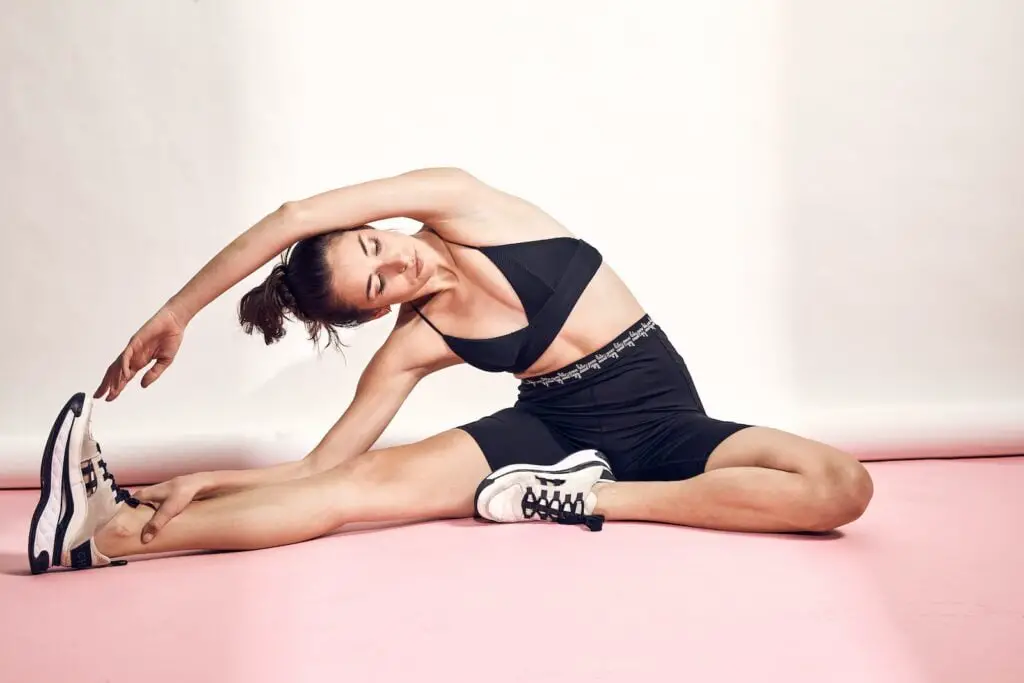A beginner workout plan for females can include exercises like dumbbell squats, elliptical workouts, and full-body exercises to build muscle and promote weight loss. Creating a workout schedule at home or in the gym using a combination of cardio and strength training can be effective for beginners.
Sample Beginner Workout Plan For Females
Empower yourself in your fitness journey with our comprehensive guide, which unveils the ultimate workout plan designed specifically for beginner females. From invigorating dumbbell exercises to exhilarating full-body workouts, we have curated everything you need to ignite your fitness transformation. Enhance your strength and endurance effortlessly within the familiar comforts of your own home or gym, courtesy of our user-friendly routines. Embarking on a fitness routine may seem daunting, particularly for novices, but fear not as we have crafted the perfect blueprint that is both uncomplicated and highly efficient.
1. Squats

Target Area of the Body: Quadriceps, hamstrings, glutes, lower back
Procedure:
- Starting Position:
- Stand with feet shoulder-width apart.
- Keep your chest up, shoulders back, and engage your core.
- Descending Phase:
- Lower your body by bending your knees and hips simultaneously.
- Ensure your knees are tracking over your toes, and your weight is on your heels.
- Aim to bring your thighs parallel to the ground or as far as your mobility allows.
- Ascending Phase:
- Push through your heels to return to the starting position.
- Squeeze your glutes at the top of the movement.
Muscles Worked:
| Step | Muscle |
|---|---|
| 1 | Quadriceps, hamstrings, glutes, lower back |
| 2 | Quadriceps, hamstrings, glutes, calves, lower back |
| 3 | Quadriceps, hamstrings, glutes |
Precautions:
- Maintain a neutral spine throughout the movement to protect your lower back.
- Be mindful of your knee position; they should not collapse inward.
- Start with bodyweight or a light barbell to master the form before adding more resistance.
- If you have any existing knee or lower back issues, consult with a fitness professional or healthcare provider before attempting squats.
- Do not allow your knees to extend beyond your toes during the descent phase.
- If you experience pain or discomfort, stop the exercise and consult with a professional.
2. Push-ups

Target Area of the Body: Chest, shoulders, triceps, core
Procedure:
- Starting Position:
- Start in a plank position with your hands placed slightly wider than shoulder-width apart.
- Maintain a straight line from head to heels.
- Descending Phase:
- Lower your body by bending your elbows, keeping them close to your body.
- Lower your chest toward the ground without letting it touch.
- Ascending Phase:
- Push through your palms to return to the starting position.
Muscles Worked:
| Step | Muscle |
|---|---|
| 1 | Chest, shoulders, triceps, core |
| 2 | Chest, shoulders, triceps |
| 3 | Chest, shoulders, triceps |
Precautions:
- Maintain a straight line from head to heels throughout the movement.
- Do not allow your lower back to sag or hips to rise.
- If standard push-ups are too challenging, start with modified (knee) push-ups.
- Keep your neck in a neutral position, avoiding excessive tilting.
3. Lunges

Target Area of the Body: Quadriceps, hamstrings, glutes, calves
Procedure:
- Starting Position:
- Stand with feet together.
- Take a step forward with one foot.
- Descending Phase:
- Lower your body until both knees are bent at a 90-degree angle.
- Ensure your front knee is directly above your ankle.
- Ascending Phase:
- Push off the front foot to return to the starting position.
- Repeat on the other leg.
Muscles Worked:
| Step | Muscle |
|---|---|
| 1 | Quadriceps, hamstrings, glutes, calves |
| 2 | Quadriceps, hamstrings, glutes |
| 3 | Quadriceps, hamstrings, glutes |
Precautions:
- Maintain good posture with your chest up and shoulders back.
- Avoid allowing your front knee to extend beyond your toes.
- Start with bodyweight lunges before adding resistance.
- If balance is an issue, perform lunges near a support or choose reverse lunges.
4. Plank

Target Area of the Body: Core
Procedure:
- Starting Position:
- Begin in a plank position with your arms straight, hands shoulder-width apart.
- Maintain a straight line from head to heels.
- Hold Position:
- Engage your core muscles to hold the plank position.
- Keep your hips level and avoid sagging or raising them.
Muscles Worked:
| Step | Muscle |
|---|---|
| 1 | Core |
| 2 | Core |
Precautions:
- Keep your neck in a neutral position, avoiding excessive tilting.
- Engage your glutes to prevent your hips from sagging.
- If wrist discomfort occurs, try forearm plank instead.
- Gradually increase the duration as your core strength improves.
5. Deadlifts

Target Area of the Body: Lower back, hamstrings, glutes
Procedure:
- Starting Position:
- Stand with feet hip-width apart.
- Hold a barbell or dumbbells in front of you with a shoulder-width grip.
- Descending Phase:
- Hinge at your hips, keeping your back straight, and lower the weights toward the ground.
- Keep the weights close to your body.
- Ascending Phase:
- Straighten your hips and return to an upright position.
- Squeeze your glutes at the top of the movement.
Muscles Worked:
| Step | Muscle |
|---|---|
| 1 | Lower back, hamstrings, glutes |
| 2 | Lower back, hamstrings, glutes |
| 3 | Lower back, hamstrings, glutes |
Precautions:
- Maintain a neutral spine throughout the movement.
- Keep the barbell close to your body to avoid strain on the lower back.
- Start with lighter weights to master the form before progressing.
- If you have back issues, consult with a fitness professional or healthcare provider.
6. Bicycle Crunches

Target Area of the Body: Abdominal muscles
Procedure:
- Starting Position:
- Lie on your back with your hands behind your head, legs lifted off the ground.
- Execution:
- Bring one knee toward your chest while simultaneously twisting your torso.
- Bring the opposite elbow toward the knee.
- Repeat on the other side in a pedaling motion.
Muscles Worked:
| Step | Muscle |
|---|---|
| 1 | Abdominal muscles |
| 2 | Abdominal muscles |
Precautions:
- Avoid pulling on your neck; use your abdominal muscles to lift your shoulders.
- Keep your lower back pressed into the floor to protect your spine.
- Perform the exercise in a controlled manner to engage the muscles effectively.
- If you experience neck pain, modify the movement or consult with a fitness professional.
7. Lat Pulldowns
Target Area of the Body: Upper back, specifically the latissimus dorsi
Procedure:
- Starting Position:
- Sit at a cable machine with a straight bar attached.
- Grip the bar with hands slightly wider than shoulder-width.
- Execution:
- Pull the bar down toward your chest, keeping your back straight.
- Squeeze your shoulder blades together at the bottom of the movement.
Muscles Worked:
| Step | Muscle |
|---|---|
| 1 | Latissimus dorsi, upper back |
| 2 | Latissimus dorsi, rhomboids, upper back |
Precautions:
- Maintain good posture with your chest up and shoulders back.
- Avoid using excessive body momentum; use controlled movements.
- Start with a light weight and gradually increase as you become comfortable.
- If you have shoulder issues, consult with a fitness professional or healthcare provider.
8. Burpees
Target Area of the Body: Full body, including cardiovascular system
Procedure:
- Starting Position:
- Stand with feet shoulder-width apart.
- Execution:
- Squat down, kick your feet back into a plank position.
- Perform a push-up.
- Jump your feet back toward your hands.
- Explosively jump up with arms reaching overhead.
Muscles Worked:
| Step | Muscle |
|---|---|
| 1 | Full body |
| 2 | Full body |
| 3 | Full body |
| 4 | Full body |
Precautions:
- Perform the exercise on a forgiving surface to reduce impact on joints.
- If you have joint issues or are new to exercise, start with modified burpees.
- Focus on maintaining proper form to prevent injuries.
- Gradually increase intensity as your fitness level improves.
9. Leg Raises
Target Area of the Body: Lower abdominal muscles
Procedure:
- Starting Position:
- Lie on your back with hands under your glutes and legs lifted off the ground.
- Execution:
- Lift your legs toward the ceiling while keeping them straight.
- Lower your legs back down without letting them touch the ground.
Muscles Worked:
| Step | Muscle |
|---|---|
| 1 | Lower abdominal muscles |
| 2 | Lower abdominal muscles |
Precautions:
- Keep your lower back pressed into the floor throughout the movement.
- Perform the exercise in a controlled manner to engage the muscles effectively.
- If you experience lower back discomfort, reduce the range of motion or consult with a fitness professional.
- Avoid using momentum; focus on using your abdominal muscles.
10. Dumbbell Rows
Target Area of the Body: Upper back, specifically the rhomboids and trapezius
Procedure:
- Starting Position:
- Bend at the hips, keeping your back straight, and hold a dumbbell in each hand.
- Execution:
- Pull the dumbbells up toward your hips, squeezing your shoulder blades together.
- Lower the dumbbells back down in a controlled manner.
Muscles Worked:
| Step | Muscle |
|---|---|
| 1 | Rhomboids, trapezius, upper back |
| 2 | Rhomboids, trapezius, upper back |
Precautions:
- Maintain good posture with your chest up and shoulders back.
- Avoid using excessive body momentum; use controlled movements.
- Start with a light weight and gradually increase as you become comfortable.
- If you have lower back issues, ensure you maintain a neutral spine during the exercise.
Benefits Of Starting A Fitness Routine
Regular exercise offers a myriad of benefits for women looking to improve their overall health and well-being. From boosting metabolism and burning calories to increasing strength and endurance, starting a fitness routine is a great way to enhance the quality of life. Additionally, exercise has been shown to enhance mood and reduce stress, providing mental and emotional benefits. Moreover, engaging in a workout plan can also help develop a toned and sculpted physique. Let’s explore these benefits in detail:
Improve Overall Health And Well-being
Regular exercise plays a crucial role in maintaining and improving overall health and well-being. It helps in reducing the risk of chronic diseases such as heart disease, type 2 diabetes, and certain types of cancer. Moreover, exercise promotes better sleep, improves digestion, and boosts the immune system.
Boost Metabolism And Burn Calories
One of the key benefits of starting a fitness routine is the ability to boost metabolism and burn calories. Regular physical activity helps in building lean muscle mass, which increases the body’s metabolic rate. This means that even when you’re not working out, your body continues to burn calories at a higher rate.
Increase Strength And Endurance
Engaging in a workout plan helps in increasing strength and endurance. Strength training exercises, such as lifting weights or resistance bands, promote muscle growth and improve overall body strength. Furthermore, cardiovascular exercises like running, cycling, or swimming improve endurance and cardiovascular health.
Enhance Mood And Reduce Stress
Exercise has a significant impact on mental and emotional well-being. It helps in releasing endorphins, which are known as “feel-good” hormones. These endorphins improve mood and reduce feelings of stress, anxiety, and depression. Regular exercise also promotes better sleep, leading to improved mental clarity and reduced brain fog.
Develop A Toned And Sculpted Physique
For women looking to develop a toned and sculpted physique, starting a fitness routine is essential. Regular exercise, combined with proper nutrition, helps in burning fat, building lean muscle, and improving overall body composition. Whether your goal is to strengthen your arms, legs, or core, targeted exercises can help you achieve a balanced and aesthetically pleasing physique.
Assessing Your Fitness Level
Looking for the best beginner workout plan for female fitness? Start with feet under hips, legs straight, holding a dumbbell in each hand, palms facing toward the body, and weights touching quads. Pull elbows up for a full-body workout. Check out the Ultimate Beginner Gym Workout Plan for Women and find the perfect routine for muscle gain.
Determine Your Current Fitness Level
Before starting any workout plan, it’s important to understand your current fitness level. This will help you assess your starting point and track your progress as you continue with the program. To determine your current fitness level, you can:
- Time yourself for a one-mile walk or run to assess cardiovascular endurance
- Measure your resting heart rate to gauge cardiovascular fitness
- Perform a push-up test to evaluate upper body strength
- Conduct a sit-and-reach test to measure flexibility
- Use a bathroom scale or body composition analyzer to track body weight and body fat percentage
Understand Your Goals And Limitations
Once you have determined your current fitness level, it’s important to set clear goals and understand your limitations. This will help you design a workout plan that is realistic and tailored to your specific needs. When setting goals, consider the following:
- What do you want to achieve with this workout plan? Is it weight loss, muscle gain, improved cardiovascular health, or overall fitness?
- What are your limitations or any physical conditions that might affect your workout? For example, if you have any injuries or medical conditions, it’s important to consider them.
- How much time can you dedicate to exercise? Be realistic about your schedule and commit to a workout plan that fits your lifestyle.
Consult With A Healthcare Professional If Needed
If you have any concerns about your health or if you are unsure about your fitness level, it is always a good idea to consult with a healthcare professional before starting a new workout plan. They can provide personalized advice and guidance based on your specific circumstances. This is especially important if you have any pre-existing medical conditions or are at a higher risk for certain health problems.
By assessing your fitness level, understanding your goals, and seeking professional guidance if necessary, you can create the best beginner workout plan for females that is safe, effective, and tailored to your individual needs.
Setting Realistic Fitness Goals
Start your fitness journey with the best beginner workout plan for females. Incorporate exercises like goblet squats, dumbbell workouts, and full-body routines to build muscle and burn fat. Find the right workout schedule for you and achieve your goals with dedication and consistency.
Setting realistic fitness goals is essential for any beginner looking to embark on a fitness journey. By defining specific and achievable goals, breaking down long-term goals into short-term milestones, and creating a timeline for each goal, you can set yourself up for success. Here’s how you can establish realistic fitness goals and stay motivated throughout your fitness journey:
Define Specific And Achievable Goals
The first step in setting realistic fitness goals is to define specific and achievable objectives. Avoid setting vague goals like “get fit” or “lose weight.” Instead, be specific about what you want to achieve. For example, aim to lose 10 pounds in three months or be able to run a 5K without stopping. By setting clear and measurable goals, you can track your progress and stay motivated.
Break Down Long-term Goals Into Short-term Milestones
Once you have defined your long-term goals, it’s important to break them down into short-term milestones. Long-term goals can feel overwhelming, but by dividing them into smaller, more manageable tasks, you can stay focused and motivated. For example, if your long-term goal is to run a marathon, start by setting short-term milestones such as running for 30 minutes without walking or completing a 10K race.
Create A Timeline For Achieving Each Goal
To ensure that you stay on track and motivated, create a timeline for achieving each goal. Setting deadlines for your milestones will keep you accountable and help you stay focused. This timeline can be flexible but should provide a clear structure for your fitness journey. For example, if your goal is to lose 10 pounds in three months, set monthly targets to track your progress and adjust your plan accordingly.
By setting realistic fitness goals, you can stay motivated and focused on your journey. Remember to be patient with yourself and celebrate each milestone along the way. With a well-defined plan and a clear timeline, you’ll be well on your way to achieving your fitness goals.
Designing Your Personalized Workout Plan
Discover the best beginner workout plan for females, designed to help you achieve your fitness goals. From dumbbell exercises to full-body workouts, find the perfect routine to build muscle, improve strength, and lose weight, whether you’re at the gym or home.
With a variety of options available, you can customize your workout plan to suit your needs and start your fitness journey today.
Choose An Exercise Program That Suits Your Preferences
When designing your personalized workout plan, it’s important to choose an exercise program that suits your preferences. This will help you stay motivated and enjoy your workouts. Whether you prefer high-intensity interval training, yoga, weightlifting, or a combination of different activities, there’s a workout program out there that is perfect for you.
Incorporate A Variety Of Cardiovascular And Strength Training Activities
It’s important to incorporate a variety of cardiovascular and strength training activities into your workout plan. Cardiovascular exercises like running, cycling, or swimming help improve your cardiovascular health and burn calories. Strength training exercises like weightlifting or bodyweight exercises help build lean muscle mass and increase overall strength.
Gradually Increase Intensity And Duration Over Time
As a beginner, it’s important to start slow and gradually increase the intensity and duration of your workouts over time. This allows your body to adapt and prevents overtraining or injuries. Start with lighter weights and shorter workout sessions, and slowly increase the weight or duration as you become stronger and more comfortable with the exercises.
Include Rest Days For Recovery And Prevention Of Overtraining
Rest days are just as important as workout days when designing a personalized workout plan. Rest days give your body time to recover and repair itself, which is crucial for muscle growth and overall health. It’s important to listen to your body and take rest days whenever you feel tired or sore. This will prevent overtraining and help you avoid injuries in the long run.
Tracking Your Progress And Making Adjustments
The best beginner workout plan for females focuses on tracking progress and making adjustments. Start with a full-body dumbbell workout, incorporating exercises like goblet squats and bicep curls. Use a workout schedule tailored to your goals and follow a routine that includes cardio and strength training.
Tracking your progress is essential to any workout plan, especially for beginners. It helps you stay motivated, monitor your improvements, and make necessary adjustments to your routine. By keeping a workout journal and monitoring changes in your weight, measurements, and fitness level, you can ensure that you are on the right track toward achieving your fitness goals. Here are some effective ways to track your progress and make adjustments accordingly:
Keep A Workout Journal To Record Your Exercises And Progress
Keeping a workout journal is a simple yet powerful tool to track your progress. Write down the exercises you perform during each workout, including the number of sets and repetitions. This will help you keep track of your achievements, identify any patterns or plateaus, and adjust your workout plan accordingly. Additionally, you can also jot down how you felt during each workout, any challenges you faced, and any modifications you made. This allows you to reflect on your progress and make informed decisions about your training.
Monitor Changes In Your Weight, Measurements, And Fitness Level
Alongside your workout journal, it is important to monitor changes in your weight, measurements, and fitness level regularly. This provides tangible evidence of your progress and helps you stay focused on your goals. Weighing yourself once a week can give you an idea of whether you are losing fat or gaining muscle. Measuring your waist, hips, thighs, and other areas of interest will help you track changes in your body composition. Additionally, regularly perform fitness tests such as timed runs, push-ups, and squats to assess your overall fitness level. These measurements will serve as benchmarks and guide you in adjusting your workout plan.
Adjust Your Workout Plan As Needed To Continue Challenging Your Body
As you progress in your fitness journey, it is important to continually challenge your body by adjusting your workout plan. When your body becomes accustomed to a certain routine, it can plateau, making it difficult to see further improvements. To overcome this, gradually increase the intensity, duration, or difficulty of your exercises. This can be achieved by adding more weight, performing more repetitions, increasing your workout frequency, or trying new exercises. By continuously challenging your body, you will keep making progress and avoid hitting a plateau.
Remember, the key to tracking your progress and making adjustments is consistency. Stick to your workout plan and monitor your progress regularly. Listen to your body, be open to making changes, and always consult with a fitness professional if needed. By doing so, you will enhance your fitness journey and achieve the best results.
Conclusion
To kickstart your fitness journey, this beginner workout plan for females is designed to help you achieve your fitness goals. Incorporate exercises like squats, lunges, and dumbbell workouts to target different muscle groups. Whether you prefer the gym or working out at home, this plan can be tailored to suit your needs. Remember to start with lighter weights and gradually increase intensity as you progress. Consistency is key, so stick to the plan and watch your strength and endurance grow. Happy exercising!
Frequently Asked Questions On Best Beginner Workout Plan For Female
What Is The Most Effective Workout Plan For Beginners?
The best workout plan for beginners combines cardio and strength training exercises. Begin with activities such as walking, jogging, or cycling for cardio, and gradually amp up the intensity. For strength training, prioritize compound exercises like squats, lunges, push-ups, and planks.
What Is A Good Workout Schedule For Beginners At Home?
A good workout schedule for beginners at home can include exercises like squats, lunges, push-ups, planks, and cardio activities like jumping jacks or jogging in place. Aim for 3-4 days a week, starting with 20-30 minutes and gradually increasing the duration.
What Is A Good Workout Schedule For A Woman?
A good workout schedule for a woman can include a combination of strength training exercises, cardio workouts, and flexibility training. Starting with 2-3 days of strength training, focusing on different muscle groups each day, and adding 2-3 days of cardiovascular exercise can be effective.
How Do I Make A Workout Plan For A Woman For Beginners?
To make a workout plan for female beginners, start with basic exercises like squats, lunges, push-ups, and planks. Gradually increase intensity and duration. Aim for a mix of cardio and strength training. Consult a trainer or use online resources for specific routines.




